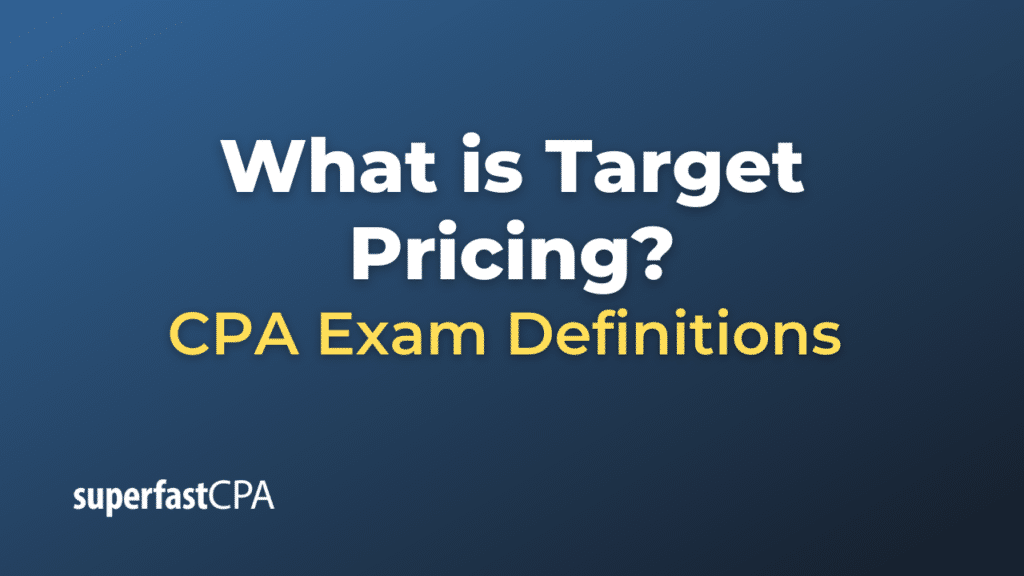Target Pricing
Target pricing is a pricing method where a company determines the desired selling price of a product based on market research and competitive analysis. Once the desired selling price is established, the company subtracts its desired profit margin to arrive at the target cost for the product. The company then tries to produce or source the product at or below this target cost to ensure it meets its profit objectives.
In essence, target pricing is customer-driven because it starts with what the customer is willing to pay and then works backward to what it will cost the company to produce the product. It places the emphasis on external market factors and customer value perception rather than solely on internal cost factors.
The steps in target pricing can be summarized as:
- Market Research: Understand what customers are willing to pay for a product or service by analyzing competitors’ prices, market demand, and perceived value.
- Determine Desired Selling Price: Set a price based on the market research that aligns with the company’s brand positioning (e.g., premium, value-oriented).
- Subtract Desired Profit Margin: This provides the target cost to produce the product.
- Cost Analysis: Calculate the current production cost based on existing processes, materials, and operations.
- Cost Management: If the current production cost exceeds the target cost, the company needs to identify ways to reduce the production cost. This could include process improvements, negotiations with suppliers, design alterations, etc.
- Implementation: The product is produced and sold at the determined price, and ongoing evaluations are made to ensure profitability.
Target pricing is especially common in industries with intense competition, fast technological change, or where products are easily comparable, like consumer electronics.
It’s important to note that while target pricing can promote cost discipline and a market-focused approach, there’s a risk of compromising product quality or value if cost-cutting becomes too aggressive.
Example of Target Pricing
Let’s use a hypothetical scenario involving a company that designs and sells smartwatches:
Scenario: TechTime Inc. wants to launch a new smartwatch to compete in a market that’s currently dominated by a few major players.
Step 1: Market Research: After analyzing competitors’ prices and gauging customer preferences through surveys, TechTime determines that consumers are willing to pay around $250 for a smartwatch with the features they’re planning to offer.
Step 2: Determine Desired Selling Price: Given the market research, TechTime decides to price its smartwatch at $240, slightly below the perceived market rate, to penetrate the market.
Step 3: Subtract Desired Profit Margin : TechTime wants a profit of $60 on each smartwatch sold. Subtracting this from the selling price gives: $240 (selling price) – $60 (desired profit) = $180.
This $180 is the target cost for producing each smartwatch.
Step 4: Cost Analysis: After evaluating their current manufacturing capabilities and supplier prices, TechTime calculates that producing the smartwatch, with all its planned features, would currently cost $200.
Step 5: Cost Management: There’s a discrepancy of $20 between the target and current production costs ($200 – $180). TechTime now explores several avenues to reduce this cost:
- Negotiating with suppliers for bulk component deals.
- Streamlining assembly processes to save on labor costs.
- Considering alternative materials that might be cheaper but still maintain quality.
After implementing various changes, TechTime manages to reduce the production cost to $185. This is still $5 above the target cost, but much closer than before.
Step 6: Implementation: TechTime launches the smartwatch at $240. They continuously monitor sales, customer feedback, and production costs, looking for further cost-saving opportunities and ensuring the quality hasn’t been compromised.
In this example, target pricing helps TechTime position itself competitively in the market, focusing on both consumer willingness to pay and their internal cost structure to determine an optimal pricing strategy.













